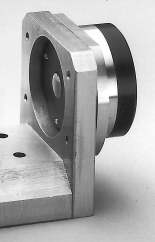 MirrorPorts
MirrorPorts
The MirrorPort contains a dielectric coated Mirror with >99% reflection. The same precision mechanism used in the FiberPorts and LaserPorts allows ultra fine adjustment of the MirrorPort to assure optimum reverse coupling of the laser beam back into the fiber. Note that MirrorPorts are interchangeable, so that other wavelengths can be easily accommodated. OFR MirrorPorts can be assembled as an orthoconjugate retroreflector (Faraday Rotator Mirror)
| The standard FMB mirror port is typically used on shorter path length retrace benches ( < 90mm). The FMB has a mirror mounted to the tilt plate surface of the standard FiberPort body. The tilt plate is then adjusted to reflect the input beam back on itself and into the incoming fiber. The FMB-LM uses an additional lens in the MirrorPort to form a reimaging system which is more efficient when coupling over longer distances. |
 MirrorPort mounted on FiberBench wall plate
MirrorPort mounted on FiberBench wall plate
|
| Standard |
Long Path Length |
Spectrum |
| FMB-VIS |
FMB-LM-VIS |
450 - 700 nm |
| FMB-NIR |
FMB-LM-NIR |
700 - 950 nm |
| FMB-YAG |
FMB-LM-YAG |
950 - 1150 nm |
| FMB-IR1 |
FMB-LM-IR1 |
1280 - 1340 nm |
| FMB-IR2 |
FMB-LM-IR2 |
1530 - 1570 nm |
| FMB-AL |
FMB-LM-AL |
Aluminum |
| FMB-AU |
FMB-LM-AU |
Gold |

FiberBench Retrace Systems
The Fiber-to-Mirror Coupling (Retrace) System consists of the FiberBench Base and one MirrorPort, with one FiberPort and one FiberCable (distal end is cleaved) serving both input/output functions. The Fiber-to-Mirror Coupling System is "empty," containing no Optical Component Modules, and is used for fiber path retrace applications. The total (2-way) insertion loss of the FMB Retrace System is 0.5-1.0 dB.

MORE INFO
|

![]()

